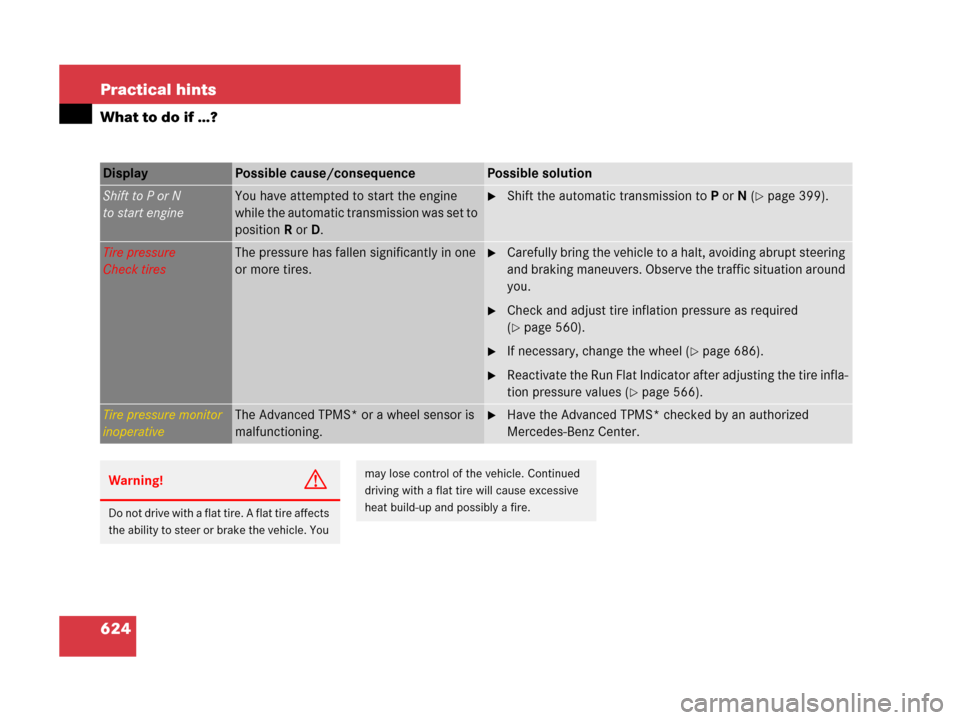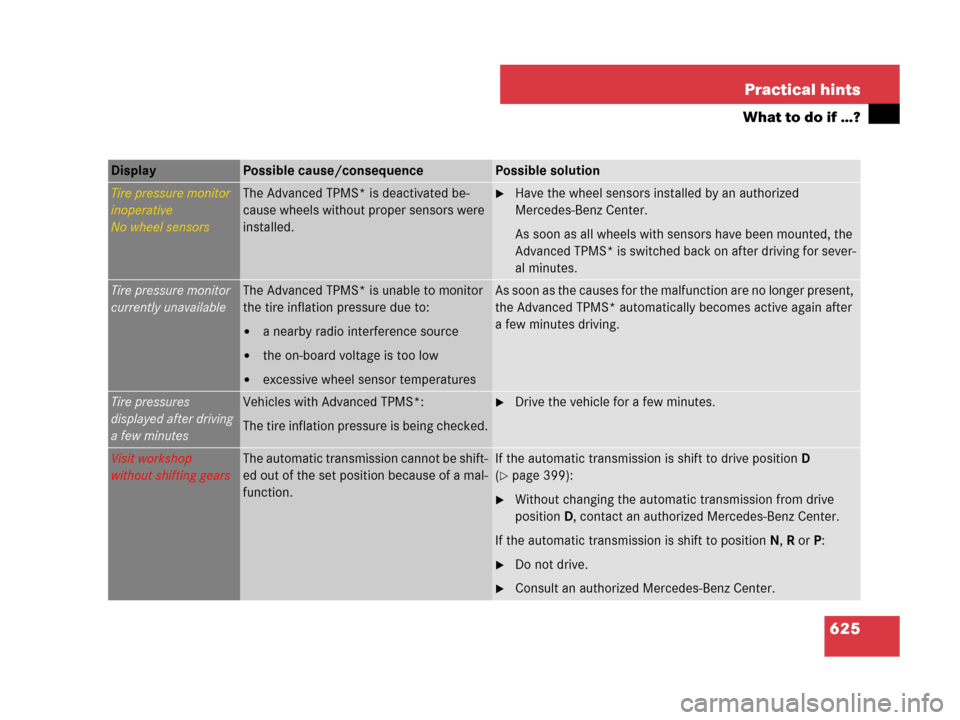Page 625 of 761

624 Practical hints
What to do if …?
Display Possible cause/consequencePossible solution
Shift to P or N
to start engineYou have attempted to start the engine
while the automatic transmission was set to
position R or D.�Shift the automatic transmission to P or N (�page 399).
Tire pressure
Check tiresThe pressure has fallen significantly in one
or more tires.�Carefully bring the vehicle to a halt, avoiding abrupt steering
and braking maneuvers. Observe the traffic situation around
you.
�Check and adjust tire inflation pressure as required
(
�page 560).
�If necessary, change the wheel (�page 686).
�Reactivate the Run Flat Indicator after adjusting the tire infla-
tion pressure values (
�page 566).
Tire pressure monitor
inoperativeThe Advanced TPMS* or a wheel sensor is
malfunctioning.�Have the Advanced TPMS* checked by an authorized
Mercedes-Benz Center.
Warning!G
Do not drive with a flat tire. A flat tire affects
the ability to steer or brake the vehicle. You
may lose control of the vehicle. Continued
driving with a flat tire will cause excessive
heat build-up and possibly a fire.
Page 626 of 761

625 Practical hints
What to do if …?
Display Possible cause/consequencePossible solution
Tire pressure monitor
inoperative
No wheel sensorsThe Advanced TPMS* is deactivated be-
cause wheels without proper sensors were
installed.�Have the wheel sensors installed by an authorized
Mercedes-Benz Center.
As soon as all wheels with sensors have been mounted, the
Advanced TPMS* is switched back on after driving for sever-
al minutes.
Tire pressure monitor
currently unavailableThe Advanced TPMS* is unable to monitor
the tire inflation pressure due to:
�a nearby radio interference source
�the on-board voltage is too low
�excessive wheel sensor temperatures
As soon as the causes for the malfunction are no longer present,
the Advanced TPMS* automatically becomes active again after
a few minutes driving.
Tire pressures
displayed after driving
a few minutesVehicles with Advanced TPMS*:
The tire inflation pressure is being checked.�Drive the vehicle for a few minutes.
Visit workshop
without shifting gearsThe automatic transmission cannot be shift-
ed out of the set position because of a mal-
function.If the automatic transmission is shift to drive positionD
(
�page 399):
�Without changing the automatic transmission from drive
positionD, contact an authorized Mercedes-Benz Center.
If the automatic transmission is shift to positionN, R or P:
�Do not drive.
�Consult an authorized Mercedes-Benz Center.
Page 665 of 761

664 Practical hints
What to do if …?
Display Possible cause/consequencePossible solution
Tele Aid
inoperativeOne or more main functions of the Tele Aid
system are malfunctioning.�Have the Tele Aid system checked by an au-
thorized Mercedes-Benz Center.
Tire pressure
Caution, tire defectVehicles with Advanced TPMS*:
One or more tires are deflating.�Carefully bring the vehicle to a halt, avoiding
abrupt steering and braking maneuvers.
�Engage the electronic parking brake
(
�page 395).
�If necessary, change the wheel (�page 686).
Caution
Tire defectVehicles with Advanced TPMS*:
One or more tires are deflating. The respec-
tive tire is shown in the multifunction dis-
play.�Carefully bring the vehicle to a halt, avoiding
abrupt steering and braking maneuvers.
�Engage the electronic parking brake
(
�page 395).
�If necessary, change the wheel (�page 686).
Warning!G
Do not drive with a flat tire. A flat tire affects
the ability to steer or brake the vehicle. You
may lose control of the vehicle. Continued
driving with a flat tire will cause excessive
heat build-up and possibly a fire.
Page 666 of 761

665 Practical hints
What to do if …?
Display Possible cause/consequencePossible solution
Tire pressure
Check tiresVehicles with Advanced TPMS*:
The pressure is too low in one or more tires.�Carefully bring the vehicle to a halt, avoiding
abrupt steering and braking maneuvers.
�Engage the electronic parking brake
(
�page 395).
�Check and adjust tire inflation pressure as
required (
�page 561).
�If necessary, change the wheel (�page 686).
Check tiresVehicles with Advanced TPMS*:
The pressure is too low in one or more tires.
The respective tire is shown in the multi-
function display.�Carefully bring the vehicle to a halt, avoiding
abrupt steering and braking maneuvers.
�Engage the electronic parking brake
(
�page 395).
�Check and adjust tire inflation pressure as
required (
�page 561).
�If necessary, change the wheel (�page 686).
Warning!G
Do not drive with a flat tire. A flat tire affects
the ability to steer or brake the vehicle. You
may lose control of the vehicle. Continued
driving with a flat tire will cause excessive
heat build-up and possibly a fire.
Page 667 of 761
666 Practical hints
What to do if …?
Display Possible cause/consequencePossible solution
Wheel sensor(s)
missingOne or more sensors malfunction (e.g. bat-
tery in one or more wheel sensor is empty).
One or more wheels without wheel sensors
mounted (e.g. spare tire).
No pressure value is shown on the multi-
function display for the tire in question.�Have the Advanced TPMS* checked by an
authorized Mercedes-Benz Center.
�Have the wheel sensors installed by an
authorized Mercedes-Benz Center.
The tire pressure for the respective tire is
shown in the multifunction display after a few
minutes driving.
Tire pressure
Please rectifyVehicles with Advanced TPMS*:
The pressure is too low in one or more tires.
Or the tire pressures of the individual
wheels differ too radically from one anoth-
er.�Check and adjust tire inflation pressure as
required (
�page 561).
Page 692 of 761
691 Practical hints
Flat tire
6Wheel wrench
�Tighten the five wheel bolts evenly, fol-
lowing the diagonal sequence illustrat-
ed (1 to 5), until all bolts are tight.
Observe a tightening torque of
110 lb-ft (150 Nm).
�Fully collapse the jack, with handle
folded in (storage position),
(
�page 669).
�Store the jack and the other vehicle
tools in the designated storage space
underneath the trunk floor
(
�page 668).
Warning!G
Have the tightening torque checked after
changing a wheel. The wheels could come
loose if they are not tightened to a torque of
110 lb-ft (150 Nm).
iVehicles with Advanced TPMS*:
Do not activate the tire inflation pressure moni-
tor until a full size wheel/tire with functioning
sensor has been placed back into service on the
vehicle.
Page 747 of 761

746 Index
ESP®29, 599, 604
Front passenger front air bag off 50,
610
Fuel reserve 605
High beam headlamp 29
Maintenance service indicator 582
Park Assist* 29
Parktronic* 29
Seat belt telltale 29, 605
SRS 29, 607
TPMS* malfunction telltale 29, 608
Turn signals 29
Language (COMAND) 238
LATCH-type child seat anchors see
Children in the vehicle
Lever
For automatic transmission
(gear selector lever) 399
For cruise control 420
For DISTRONIC Plus* 430
License plate lamps
Messages in display 655
Replacing bulbs 679
Light alloy wheels, Cleaning 593Light sensor
Message in display 654
Lighter see Cigarette lighter
Lighting 371
Automatic headlamp mode 372
COMAND display illumination 87
Corner-illuminating lamps 376
Courtesy lighting 380
Daytime running lamp mode 373
Door entry lamps 379
High beam flasher 375
Instrument cluster illumination 417,
463
Interior 378
Manual headlamp mode 372
Trunk 380
Limp-home mode 416
Loading see Vehicle loading
Locator lighting (COMAND) 243
Lock button
Door handle (KEYLESS-GO*) 338,
388
Key, SmartKey 332
Key, SmartKey with
KEYLESS-GO* 335Locking 394
Automatic central locking
(COMAND) 245
Vehicle in an emergency 672
Locking knob 341
Loss of
Key, Mechanical 340
Key, SmartKey 340
Key, SmartKey with
KEYLESS-GO* 340
Service and Warranty Information
Booklet 711
Low beam headlamps
Replacing bulbs 679
Lowering
Vehicle 690
Lubricants 724
Lumbar support (COMAND) 260
Page 756 of 761

755 Index
Telephone cradle
Changing 509
Telephone* 507
“911” emergency call
(COMAND) 135
Accepting/ending a call
(COMAND) 142
Answering/ending a call (Instrument
cluster control system) 279
Call lists (COMAND) 140
Changing mobile phone cradle 509
Compartment 495
Dialing (Instrument cluster control
system) 277
Entering the telephone number
(COMAND) 143
Hands-free microphone 33
Inserting in cradle 508
Installing a different mobile phone
cradle 510
Operation 276
Operation (COMAND) 132
Phone book (COMAND) 147
Phone book (Instrument cluster control
system) 277
PIN (COMAND) 136PIN2 (COMAND) 137
PUK / PUK2 (COMAND) 137
Redialing (COMAND) 143
Redialing (Instrument cluster control
system) 278
Removing from cradle 509
Single call connection
(COMAND) 145
Speed dialing (COMAND) 144
Submenu overview (COMAND) 138
Switching on/off (COMAND) 134
Transferring a call (COMAND) 146
Unlock code (COMAND) 137
Voice Control* 289
Temperature
Outside temperature indicator 29
Setting interior temperature
(COMAND) 252
Tires 559
Tie-down hooks, Trunk 500
Tightening torque, Wheel bolts 691
Tilt/sliding sunroof see Power tilt/sliding
sunroof
Time
Setting (COMAND) 235
TIN 578Tire and Loading Information
Placard 554
Tire Identification Number see TIN
Tires 550
Advanced Tire Pressure Monitoring
System (Advanced TPMS)* 561
And Rims 718
And Wheels 550
Care and maintenance 551
Chains 581
Checking inflation pressure electroni-
cally with Advanced Tire Pressure
Monitoring System
(Advanced TPMS)* 561
Checking inflation pressure electroni-
cally with Run Flat Indicator
(Canada only) 565
Cleaning 552
Cold tire inflation pressure 576
Combination low tire pressure* mal-
function telltale 29, 608
Direction of rotation 553
Driving instructions 531
Important notes on tire inflation
pressure 559
Inflation pressure 558